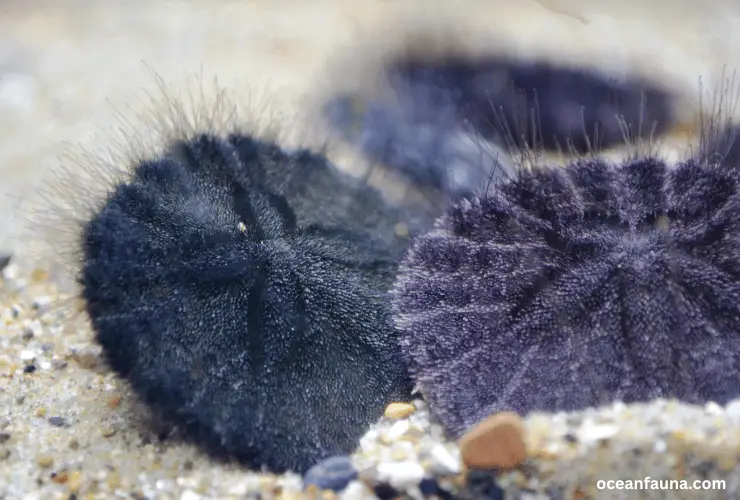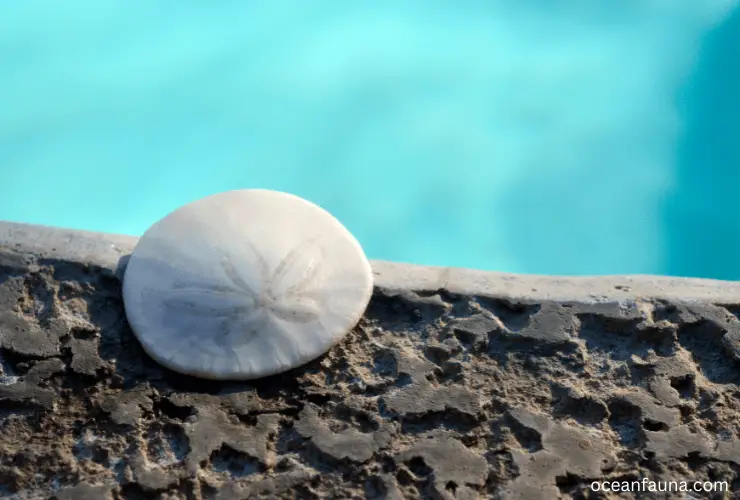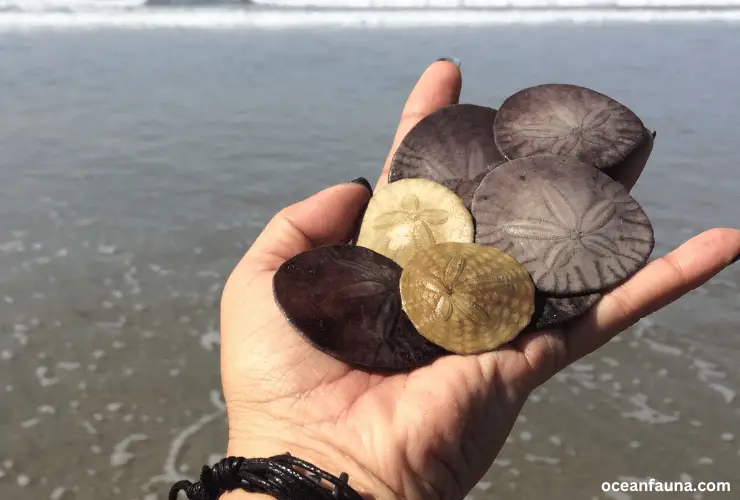Sand Dollars have an average lifespan of 8 to 10 years. They are dioecious. The life cycle comprises 4 phases: egg, Larvae, Juvenile, and Adult. After that, they die either due to a predator attack or another reason.
Interesting? Then quickly grab a cup of tea and walk through the details of this minute organism.
Now, without further ado, let’s unravel more about Sand Dollars.
About Sand Dollar- Some Insane Facts
- Kingdom: Animalia
- Higher classification: Gnathostomata
- Phylum: Echinodermata
- Class: Echinoidea
- Superorder: Gnathostomata
- Name: Clypeasteroida
Sand Dollars are flat, round-shaped organisms with a velvety soft appearance. However, they aren’t soft. Instead, their exoskeleton is made of Calcium Carbonate test.
Sand Dollars comprise five rows of pores and therefore exhibit radial symmetry. They are of different colors, i.e., purple, brown, violet, and green, depending on the type of species.
Their scientific name is Clypeasteroida. However, they have many common names, like sea cookies, snapper biscuits, sand cakes, sand urchins, etc.
What Is the Lifecycle Of A Sand Dollar?
The lifecycle of the sand dollar comprises four main stages, from birth to death. These include:
- Egg
- Larvae
- Juvenile
- Adults
Now, let’s dive through the details of each section.
Lifecycle Of the Sand Dollar
1. Birth (How is a sand dollar born?)
The way of production of sand dollars is quite different from that of humans and other mammals. Mammals can mate mostly at any time of the year and produce offspring.
But unfortunately, that isn’t the case with sand dollars.
Mating Season
They have a limited mating period of 2 months, i.e., May and June.
Releasing of Eggs
In this period, the two sexes release their gametes (egg and sperm) in the water. Then, the male and female gametes combine and hatch to bring into being a fertilized egg.
However, the fertilized egg won’t become an adult straight. Instead, it has to go through multiple stages of growth and development.
Struggles
The life of a baby sand dollar isn’t that easy. They aren’t inside the womb of females like in the case of kangaroos or humans to provide protection.
Neither are they covered with eggs or Shells like birds and reptiles.
Instead, they are all exposed to marine animals. Therefore, they have a lot of danger of being engulfed by a predator like a sea gull or hitting some hard stone.

Therefore, they mostly swallow sand grain to stay on the bottom of the sea floor.
Moreover, they have a remarkable ability to catch the signal of predators. So, if they detect fish mucus, they clone into two to further reduce their size. In this way, they protect themselves from the evil eye of predators.
Age facts
Sand Dollars are quite different from us. They have a limited lifespan, like insects, and die after 8 to 10 years in most cases. Only a few manage to live up to 13 years.
Daily life -Mealtime
One is often left with utter surprise when eyeing their digestive and alimentary system.
They have a separate mouth and anus. However, they don’t have distinct teeth like molars and premolars. Instead, five sets of shark rocks are present that function as teeth.
The tube feet on the surface help to capture food and move it to the mouth. Surprisingly, sand dollars take more than two days to digest their meal.
Purses
Sand Dollars don’t live alone or separately. Instead, they live in the form of a crowd called a purse. These unique sea organisms are so small that nearly 625 sand dollars can unite in just 1 Square yard.
Insane!
2. Reproductive System
After the formation of the egg, it transforms into the following two stages one by one.
Larvae
Soon after fertilization, the egg is termed a Larvae. However, the stage still needs to be completed. It undergoes multiple divisions until it becomes an 8-arms Pluteus, with a size of nearly 0.03 inches.
First, it develops two arms that divide into 4, 6, and finally eight arms.
However, they are quite small in size. It takes nearly six weeks for a larva to develop eight arms and attain a size of 0.03 inches.
Keep in mind, at this stage, the baby sand dollar has undergone no development.
Juvenile
This stage is categorized as the phase of ultimate growth and development.
Soon after the Larvae develop eight arms, it settles on the bottom of the seafloor and undergoes metamorphosis, just like toads.
It takes nearly 90 minutes and then undergoes structural development. Within a short period of 7 days, the Juvenile sand dollars develop gut, anus, mouth, and spins.
3. The Last Stage of Sand Dollars Life
After the Juvenile stage, the sand dollar becomes an adult. It remains in this phase for the rest of its life (8 to 10 years).
They feed on crustaceans, detritus, debris, and phytoplankton during this stage. Moreover, to defend themselves, they eat grain to settle at the bottom of the sea floor. Else, they go for the burrowing technique. They burrow themselves under the thick layer of sand.
But since they don’t have any proper defense mechanism, the strong currents and tides often lead to their death, resulting in various white sand dollars washed up on the beach.
How Do Sand Dollars Reproduce?
Sand Dollars mainly reproduce through broadcast spawning, a form of serial reproduction. However, they also undergo cloning, a form of asexual reproduction, at some point in their life.
Broadcast Spawning
Broadcast spawning is an external fertilization process. Both sexes (males and females) release their sperm and eggs in the ocean. Later, the gametes combine and fertilize.
Since sand dollars prefer to live in a crowded form called Purses, they have an advantage in broadcast spawning. As a result, many of the eggs get fertilized.
Cloning
During the fertilized larva stage, sand dollars have no test or exoskeleton to protect them. So, they reproduce asexually by cloning. This helps them reduce the size yet increase their number.
Are Sand Dollars Black When They Are Alive?
Kind of YES!
Sand Dollars are quite dark-colored when alive. They have a vibrant purplish brown appearance that mostly looks black in the absence of bright light. They have a very velvety appearance due to the presence of hundreds of thousands of spines and tube feet.

However, when it dies, the production of pigment (Naphthoquinone) responsible for the color ceases. As a result, the purple color disappears, and they turn white.
How Long Do Sand Dollars Stay Alive?
An average estimate is that sand dollars stay alive for nearly 6 to 10 years. After this, the sand dollars shed off their spines and cilia. As a result, they fail to eat, capture prey, and move properly- ultimately leading to death.
How Long Can a Sand Dollar Live Out of Water?
Sand Dollars are marine invertebrates. They can simply not live out of the water like fish.
So, if you find a sand dollar living out of the water, it’s better to put it back in the water.
They can survive out of the water on the land for only a few minutes, and then it dies out.
The reason is that they don’t have gills or lungs to take in oxygen for respiration.
Instead, oxygen from the water is absorbed by the canal for respiration.
So, if placed out of water for a long time, they fail to breathe properly, ultimately leading to death.
Frequently Asked Questions (FAQs)
Q.1 How to tell how old a sand dollar is?
You can age a sand dollar just like trees. Growth rings are present on the plates of the calcium carbonate shell. So, you can count the ring to get an estimate of the age. Usually, they live for 6 to 10 years.
Q.2 How long does a live sand dollar take to turn white?
Usually, a sand dollar turns completely white within 24 hours of dying. The UV and other sun rays cause the skeleton to fade out, leaving it with a white-colored test.
Q.3 How long does a live sand dollar take to dry out?
A sand dollar can’t live without water on the sand for long. So, it dries out within a few minutes after exposure to sun rays.
Q.4 How long does it take a sand dollar to die?
An average lifespan of a sand dollar is 6 to 10 years. After it, the sand dollar stays to lose its spins. As a result, it fails to eat and move. Consequently, it dies. When it dies, its color changes from purple to silvery white.
Final Verdict
To cut a long story short, sand dollars are a unique type of echinoderm. They have a small lifespan of six to ten years.
Their entire life is divided into four stages: eggs, larvae, juvenile, and adult-the last stage.
After which, they start to lose spines and ultimately die.


6 thoughts on “Life Cycle of a Sand Dollar | Amazing Finding”